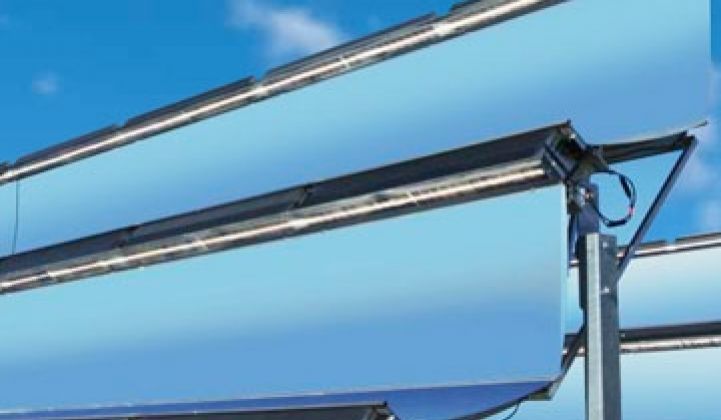Skyline Solar plans to raise a second round of funding later this year to propel it into commercial production, said CEO and co-founder Bob MacDonald.
The Mountain View, Calif.-based startup is developing a solar energy system that uses metal reflectors to concentrate the sunlight onto silicon solar cells for electricity production. MacDonald said he hasn't settled on how much he would like to raise later this year, but the round is likely to be less than the $24.6 million he raised last year from investors including New Enterprise Associates.
MacDonald discussed his company's technology and business plan during a shindig to unveil the company's 27-kilowatt pilot system at the Santa Clara Valley Transportation Authority (VTA) in San Jose last Friday afternoon. The event afforded local and state dignitaries and fellow solar companies a close-up look of Skyline Solar's technology. Mark Crowley, CEO of SolFocus showed up for the event, as well as employees from SunPower and others. MacDonald headed SolFocus' product marketing program before starting Skyline in 2007.
The VTA is providing the land to Skyline in exchange for getting the electricity from the 27-kilowatt system for free. The pilot project is planned for 18 months, and it's the first grid-connected solar power system for the transportation authority, said Michael Hursh, deputy director of the VTA.
Skyline, which has about 50 employees, plans to use the pilot project to figure out how well its technology can generate electricity and what other changes should be made to reduce labor and material costs.
For example, the company installed six single-axis trackers in one row of reflectors but used only three trackers for another row to gauge the benefits and disadvantages of using fewer trackers. The system also sports solar cells from different suppliers in Europe and Asia, though MacDonald declined to disclose their names.
All these efforts would enable the company to tweak the system's design and get ready for a product launch in the fall, said Teresa Trowbridge, director of reliability for Skyline.
The pilot system is consisted of slightly curved steel reflectors coated with silver and titanium dioxide for protecting the equipment from the elements, MacDonald said. The reflectors concentrate and direct the sunlight onto monocrystalline solar cells, which can convert sunlight more efficiently than the cheaper multicrystalline solar cells. Most of the solar panels sold on the market today are made with these two types of cells.
By boosting the sunlight 10 times its usual intensity, the system wouldn't need to use as much silicon to produce ample power. This approach was especially attractive when silicon prices were high a few years ago, leading solar panel makers to compete fiercely for the raw material. It might not be so anymore, however, given the decline of silicon prices, said Eric Wesoff, a senior analyst with GTM Research (see CPV: Stuck in the Middle and Polysilicon Prices Head for a Steep Fall).
Some of the other concentrating photovoltaic startups, such as SolFocus and GreenVolts, are pursuing what's called "high concentration PV" technologies because their systems could enhance the sunlight's intensity hundreds of times. These companies also use solar cells built with more expensive but highly efficient materials such as gallium-arsenide (see SolFocus Boosts Solar Efficiency).
MacDonald contended that the abundance of silicon would in fact be an advantage for Skyline to market its technology. And low concentrating technology is cheaper to deploy than the high concentration variety, he added.
"We are looking for materials that are widely available," MacDonald said. "If we want to have an impact as an industry, we have to be able to scale up to hundreds of gigawatts per year."
Indeed, the key to all these startups' success is to be able to produce electricity cheaply. They are competing not only with fellow concentrating PV companies, but also those developing solar-thermal power and solar-panel systems. Skyline wants to build systems for commercial, industrial and municipal customers. MacDonald said the company also is interested in talking to real estate developers who are building residential communities with land set aside for renewable power projects.
MacDonald declined to discuss the costs of installing a Skyline system. To build the pilot project, the company bought rolls of aluminum from an air conditioning and heating system maker in Silicon Valley, he said.
Skyline is now working on contracting with an automotive assembly plant in Michigan for the commercial production of its reflectors and other components, MacDonald.
Join industry leaders and influencers at Greentech Media's Concentrating Solar Technologies & Markets at Intersolar in Munich, Germany on May 29.




